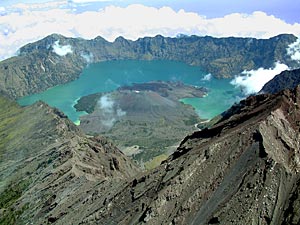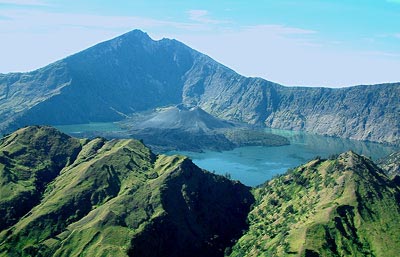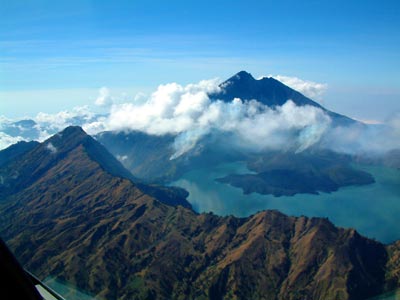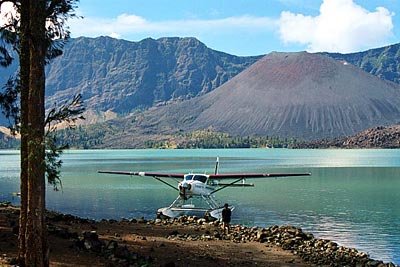Challenge & Response:
![]()
Or how to
talk yourself into landing inside an active Volcano
![]()

Modern CRM teaches pilots the value
of the Challenge and Response system for referencing checklists. Here is
an example of how the system works.
Have you ever found yourself circling deep
inside the ancient rim of an active 13,000 ft volcano wondering how you
got there? Then as you continue to circle have you felt the pressure
mounting to decide whether or not to continue? Now is the time to
reference the POH and find the correct checklist. If volcanoes are not
covered in the Supplement Section you can pull out now to save face and
just say, “It wasn’t in the book, so why risk it?” Most people would
nod their heads in consensus and agree wholeheartedly that you did the
right thing.
The Challenge:
“I mean, look at the risks. Did you even
contemplate the risks? Shame on you for even considering such a thing.”
“First of all, isn’t there some kind of
law preventing you from landing inside a volcano? I mean if there isn’t
one, there ought to be. And isn’t the volcano inside a national park.
That means it is protected. If you land there then you might be violating
some kind of regulations. Plus, you’d be out of radio contact with
flight control. What if something happened? No, you had better not go at
all.”
“What about the weather? There must be
strong downdrafts coming off the mountain. Would you be able to climb out
once you got in? And you know the volcano clouds over every day. You would
not be able to see the mountain in the cloud. What do they say about
clouds with granite centers?”
“You also have to remember that this is
an “active” volcano don’t you? It last erupted with a heavy lava
flow only as recently as 1994. Can you imagine what would have happened if
you had been there at the time? Hah, you’d be toast. Or soup. Not to
mention that this particular volcano has been rated as one of the eight
most dangerous volcanoes in the world! This baby is a pressure cooker. It
can go at any time. Do you want to be there when that happens? Think about
that.”
“Not to mention that no one has measured
the depth of the lake. You could easily hit a rock and sink the floatplane
on landing.”
“And there is basic chemistry to
consider. Every one knows that volcanoes turn water into sulfuric acid.
Haven’t you seen the movie? Landing there would certainly corrode the
floats. You could sink on the spot. Apparently sulfuric acid will strip
the flesh right from your bones. Yeetch!”
“Worst yet, don’t you remember that
volcano eruption in Cameroun where the vent gasses turned the water in the
lake to a carbolic gas that killed every cow and cat and villager around
for miles. Remember, the first reports said the Israelis had tested a
Hydrogen bomb. That was the only way they could explain the mysterious
deaths, because by the time they got there the gas had cleared and they
found nothing but bodies. Even the cockroaches were dead. Even the fleas
on the dogs were dead!”
“Never mind all that,” says the Chief Pilot. “I
checked the Pilot Operating Handbook and the charts don’t even go that
high. This lake we are talking about is at 7,000 feet above sea level. You
can’t extrapolate these charts so you really do not have a choice. The
manufacturer has the last say in how this aircraft can operate and you can’t
make it do what it won’t do. It was simply impossible anyway so why try?
Besides you have your family to consider.”
“Now, let’s forget all this nonsense
and go for a beer.”
We have all been
there.
Challenges come from all arenas of your
life: mental, physical, social. For some of us just getting up in the
morning is a challenge. This type of challenge is wholly psychological in
that you have convinced yourself there is nothing worth getting up for.
The challenge here is to “face the day” if you are stuck in a
situation where you have little control, or to “face the music” if you
have recently messed up. A physical challenge is getting up in the morning
after going on a bender the night before. A social challenge is facing
your girlfriend after making out with her best friend while you were under
the influence the night before. We have all been there.
The pressures and decisions of our
day-to-day lives are our challenges. Man’s response to these challenges
has been to control the environment around him. To delay darkness he has
constrained fire, to avoid rain he has built shelter, to foregoing famine
he has bred the self-protecting poisons out of plants and the wildness out
of animals, to protect against marauders he has fashioned spears, and to
counteract pain he has chewed the bark of willows.
When a hurricane blows away his shelter,
however, or a flood washes away his livestock, man is really whistling in
the wind. It is those times when man’s control slips away leaving
nothing but the primitive rite of survival. Those mornings after are
really when it would be tough to get out of bed, if you have a bed to get
out of.
Natural disasters
can ruin your whole day.
Hurricanes, floods, tornadoes, wild fires,
and earthquakes are all beyond our control and for the most part
unpredictable. Most animals have evolved to have an instinctual fear of
natural disasters. Birds fly inland from hurricanes; deer head for high
ground in floods; wildebeest stampede from wild fires. Evolution has
traced that protective fight or flight pattern into our survival
instincts. Man, however, has the ability to learn from experience and can
live with the worst of his fears. Besides, not all disasters are all bad.Volcanoes, like floods and wildfires, bring not only disaster, but good as well. They enrich the soil: floods and fires for the season and volcanoes for generations, leading to a confused state of a primitive mind. When they come they bring death and destruction, but when they finish they allow crops to thrive and civilizations to flourish. How does a society deal with that concept? When you live beside a river or a meadow, do you fear it’s destructive potential to swell into a flood or rage into a wild fire? Or do you view these landscapes as benign and serene? For the most part, I believe people see a river as a river and a meadow as a meadow and leave it at that.
There is something decidedly different, however, about a volcano. A volcano can be nothing else. It cannot become a volcano. It is a volcano and therefore the potential or threat is always present.1 You may build your woven grass shelter or plant your subsistence crops on the side of a volcano, but when you look up from hoeing your cassava it is still a volcano. It is a hostile landscape that is only temporarily man’s to borrow.
A majestic and awesome volcano towering over and dominating the landscape stirs the deepest fears of man. These fears are not just about running away, but something more spiritual. Those fears are of the unknown. The volcano inspires the imagination and fires the soul. The volcano makes man believe in gods and in other worlds. The volcano makes man wonder where heaven is when hell breaks loose. Fire and brimstone and obsidian projectiles disgorge from the bowels of the shaking earth. Steaming poisonous gasses spew forth. Erupted smoke and ash and dust turn the sky dark and the air becomes un-breathable. Molten rivers of red-hot lava destroy everything in its path. This is hell on the move. This is not a place for man.
The PropThrust Response:
"Where do they want me to land the floatplane?Damn! Well ...ok.
Anyone see smoke?"

Article and Images by John S
Goulet
![]()
Write to PropThrust with your ideas of what is right from wrong and get published on Virtual Horizons.
Use the attitude indicator as your guide back to eBush Communications.
 Top of this
page.
Top of this
page.
Return to Knowledge Based Stories.
Last modified on
June 15, 2006 .
© Virtual Horizons, 1996.